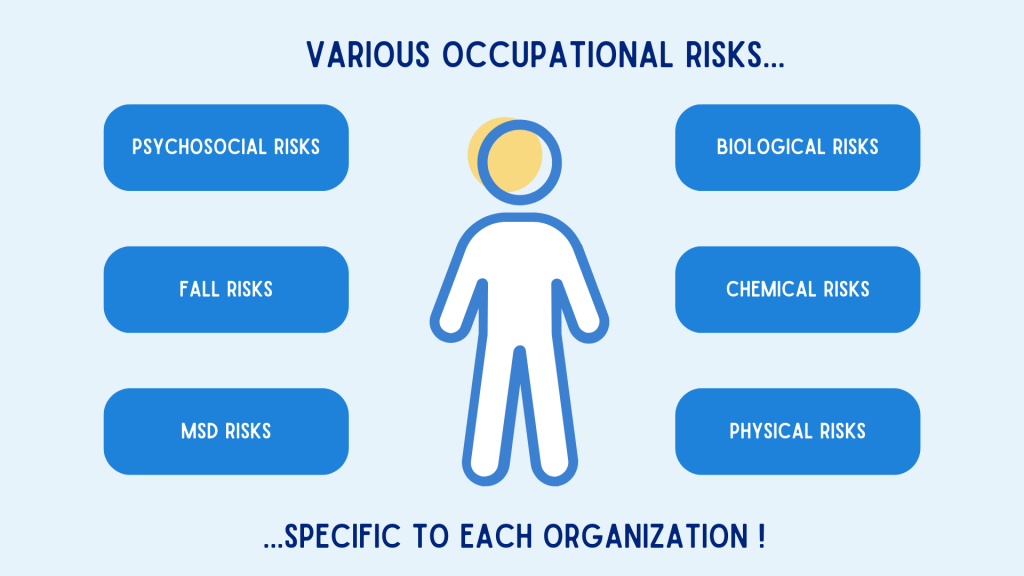Let’s talk about health and safety at work !
We spend a major part of our time at work. Everyone wants to feel fulfilled in their job, both through the tasks they perform and the professional environment around them.
Health and safety are key aspects of workplace well-being, but it’s not always easy to know how to address this issue within a company. Employees, HR, managers, or even executives… Who should you turn to for effective discussions and to contribute to improving health and safety in the workplace?
Moovency has decided to share best practices regarding health and safety at work ; shall we take a look together?
Moovency a décidé de vous détailler les bonnes pratiques concernant la santé et la sécurité au travail ; on regarde cela ensemble ?
I) Health and Safety at work : What are the employer’s obligations ?
Health and safety at work are European concerns. In France, the Labor Code governs all employer obligations regarding health and safety at work. Employers must take the necessary measures to ensure the safety and protect the physical and mental health of workers. They must also assess occupational risks for each job and adopt necessary actions to prevent workplace illnesses and accidents.
Consequently, several measures must be implemented by an employer (Article L4121-1 of the Labor Code):
– Actions to prevent occupational risks
– Information and training initiatives for employees
– The establishment of an appropriate organization and resources
If these measures are not respected, the employer may face criminal sanctions, court convictions, and financial reparations.

II) The stakes of health and safety at work
Why is it so important to talk about health and safety in the workplace ?
Employees of a company are on the front lines and are most likely to be victims of occupational risks, which can cause significant damage to their mental and physical health. Including health and safety issues in the workplace helps to empower employees while strengthening the company’s culture of prevention and raising awareness of various risks.
Indeed, the absence or lack of communication about health and safety issues at work can lead to harmful problems for both employees and the company:
- Increase in occupational illnesses and accidents.
- Rise in absenteeism.
- Decrease in productivity.
- Activity restrictions.
- Risky behavior among employees.
- Increase in contributions; …
In summary, there are direct and indirect costs and a decrease in performance for the affected employee and company.
III) Stakeholders in workplace safety
Who is involved in health and safety issues at work ?
Everyone in the work environment is involved in health and safety at work! Within the company, everyone, regardless of their hierarchical status, has a role, responsibilities, and rights in terms of health and safety at work.
- The leader(s): As the head of the company, they are responsible for implementing actions, measures, and risk assessments, and determining the resources to be allocated to them. It is their responsibility to ensure a work environment that respects health and safety issues, in accordance with current legislation, for their employees.
- HR departments: Responsible for deploying prevention policies and raising awareness among employees about health and safety issues at work.
- Managers and supervisors: Responsible for supervising teams, managers play a role in health and safety at work and must ensure compliance with safety standards and encourage a culture of prevention. It is also their role to report any issues that may cause harm to a colleague’s physical or mental health.
- Employees themselves: As the first stakeholders, employees are also responsible for their own safety in terms of health and safety at work. By raising awareness of risks, employees play an important role in following established safety rules and signaling potential hazards.
And to go further, we can also mention employee representatives or occupational health services, which also play key roles in health and safety in the workplace.
IV) How to establish dialogue and a good prevention culture around health and safety at work ?
To promote a healthy and safe work environment and adopt a good prevention culture, one of the essential levers is to raise awareness and train employees about occupational risks.
By bringing teams together around the issues of health and safety at work, collective reflection can be established to take sustainable initiatives.
- Employee Training: Through regular training sessions, employees are better sensitized to situations at risk. Not all employees have the same degree of knowledge of these risks or the same perception. Sensitizing them allows them to become actors in their own prevention and to understand the issues of health and safety at work.
- Engage Employees in a Collective Approach: Involving employees in the occupational health and safety process also mobilizes them on these issues. For example, by incorporating group workshops, questioning employees about their physical or emotions, or simply conducting a weekly review of work activity, you can strengthen employee mobilization and identify various health and safety issues.
- Enhance Internal Communication: Improving internal communication within the company makes it easier to discuss health and safety at work. Providing information on best practices, correct use of personal protective equipment (PPE), making informative communication materials available on health and safety at work, promoting a culture of prevention… Active communication on this subject allows for complete transparency and creates better dialogue within the company.
- Active Listening: Finally, to easily discuss health and safety at work, regularly collecting employees’ impressions and testimonies helps create a climate of trust and facilitates dialogue on the subject.
To conclude
Discussing health and safety at work is much more than just an administrative formality; it is a shared responsibility that directly contributes to the quality of life of workers and the overall performance of the company.
One key to success is the involvement of all stakeholders in the company, from leaders to employees, including human resources managers. By adopting a proactive and collaborative approach, companies can create a safe work environment where employee well-being is a priority.
This approach not only reduces the risks of accidents and occupational diseases but also fosters increased employee engagement and overall improvement in productivity and job satisfaction.
